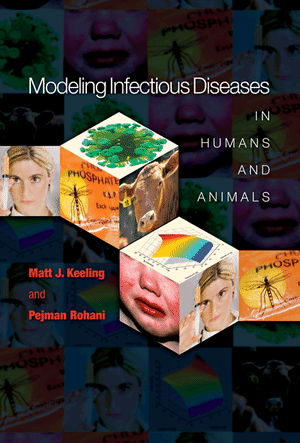Below is the text from reviews that have been published about Modeling
Infectious Diseases.
Nature -- by Mark Woolhouse, Lancet Infectious Diseases -- by Sally Blower
Nature
Infections produce further infections. The implications
of this simple observation have long intrigued theoreticians and
confounded empiricists. It implies nonlinear dynamics, to use the
mathematical jargon, and this makes it difficult to be intuitive about
what will happen next, especially if the intention is to intervene.
Expert opinion is often not up to the task; we also need the insights
provided by mathematical models. These are being widely used to help
understand the epidemiology of infectious diseases and to design
control programmes. Models can support, add to and sometimes even
overturn prevailing wisdom — think of malaria, AIDS, measles or
foot-and-mouth disease.
In 1991, Roy Anderson and Robert May published the
hugely influential Infectious Diseases of Humans (Oxford
University Press). The subject has since advanced significantly, and Modeling
Infectious Diseases in Humans and Animals
meets the need for a new synthesis. Authors Matt Keeling and Pejman
Rohani are mathematicians by training who have made important and
original contributions to epidemiology, so they are well qualified to
deliver an authoritative, comprehensive and up-to-date review.
Their
book contains a guide to different models and provides worked examples
of the insights that models offer, and of specific applications to
real-world problems. They cover an impressive range of mathematical
approaches, from two-line coupled differential equations through
event-based stochastic models to spatially explicit microsimulations,
and many others. Their examples cover an equally wide range of
infectious diseases, from measles in school children to sexually
transmitted infections in koalas. In every case, there is a thoughtful
description of the rationale for the model, the assumptions behind it,
the types of question it can be used to address, how to implement it
(helpfully supported by a website providing access to computer code),
and what the model tells us.
With all of this to
hand, is the reader fully equipped to become a modeller of infectious
disease? Not quite. Modelling is more than a technical exercise. It
also requires that the practitioner makes critical judgements at
different stages of the process, notably design, parameterization,
validation and prediction.
Model design is the first
and most important step. Success depends on how well we pose the
questions we want to answer, and how effectively we identify the
essential biology and translate it into mathematical equations or
computer code. Keeling and Rohani manage this effortlessly, but it is a
difficult art to instil in others except by example. There are plenty
of examples in their book that repay close attention: particularly the
sections on seasonality and contact tracing.
The second step, and an active area in the field, is
model parameterization. It is not a major theme of Modeling
Infectious Diseases.
It was once acceptable to run a projection through some data points and
declare the model good enough. This is no longer the case. More
powerful computers and software have increased the availability of
sophisticated estimation techniques, often using bayesian methodologies.
The
third step is validation — the extent to which we should believe, and
sometimes act on, the output of a model. Keeling and Rohani take a
mathematician's view of this. Their book is punctuated by concise
summaries of the insights drawn from the models, presented as robust
conclusions. These are helpful in communicating key results but
empiricists will often, rightly, demand something more. Ideally, this
should include testing model predictions against independent data.
Prediction
is a difficult task that we routinely undertake, for example, when
making a decision about implementing disease-control measures. Such
decisions must always involve some kind of model, even if it is only a
mental one. Mathematical models have two huge advantages. First, they
are transparent — the inputs, assumptions and logic are available for
inspection, criticism and change in a way that is rarely the case for
expert opinion. Second, models can be used to explore, in silico,
the expected impacts of many more different control options than could
ever be trialled in practice. Often, models will be the best evidence
we have for our decisions.
Keeling and Rohani
advocate, as strongly as I do, the use of mathematical models to help
design disease-control programmes and they devote the final chapter to
this topic. They recognize that modelling is a partnership between
modellers and empiricists, including experts in the disease system of
interest, providers of epidemiological data and those responsible for
disease control. For that reason, I hope that the readership of Modeling
Infectious Diseases
will extend beyond existing and new devotees of this challenging and
exciting discipline. Most medics, vets and health workers will never
write a mathematical model themselves, but it is increasingly important
that they are familiar with the work of those that do.
Mark Woolhouse
Lancet
Infectious Diseases
An informative textbook, Modeling infectious diseases in humans
and animals is written by a mathematician (Matt Keeling of the
University of Warwick, Coventry, UK) and a physicist (Pejman Rohani of
the University of Georgia, Athens, GA, USA). The authors assume in the
reader a fairly sophisticated knowledge of mathematics and
computational techniques, and the book is clearly aimed at advanced
undergraduates or graduate students with a strong background in
mathematics. A series of mathematical models, of increasing complexity,
is clearly presented and the reader is taken through the appropriate
mathematical analyses. A particularly nice feature of this book is that
it includes web-based mathematical exercises.
The authors begin by describing simple epidemic models (focusing on the
classic susceptible–infected–recovered model and its modifications) and
then quickly progress to multi-pathogen/multi-host and temporally
forced models, stochastic dynamics, and spatial models. Each chapter
carefully explains the mathematical structure of a particular model
(most of the models are based on a series of ordinary differential
equations) and concludes with a few examples of the application of this
type of model to a specific infectious disease of animals or human
beings. Since the research of both authors is concerned with modelling
childhood diseases, they have mainly selected examples from this area
of modelling. Admittedly, this book is a textbook aimed at explaining
some of the methodologies of modelling and does not intend to be a
review of the literature of this field. However, I was disappointed that
models of diseases of major medical importance such as HIV,
tuberculosis, malaria, or hospital-acquired infections were not
covered. Consequently, the reader is not made aware of the very large
body of modelling literature that has focused on diseases that have
great importance to public health.
The field of modelling infectious diseases is divided into two camps:
those who believe that simple mathematical models are useful for
understanding epidemiology and making predictions, and those who
believe that complex models are necessary for making accurate
predictions. Both simple and complex models have advantages and
disadvantages. Simple models are constructed on the basis of a few
assumptions (that are usually made transparent) and a few parameter
values. Generally, these models are thoroughly analysed both
mathematically and numerically. Uncertainty analyses have been used to
make predictions from simple models (ie, the predicted outcomes have
error bars). Multivariate sensitivity analyses have been used to
investigate the effect of all of the assumptions and ranges in parameter
estimates on the predictions.
Simple models have therefore provided a great deal of insight into the
dynamics and control of infectious diseases. However, if a model is
over-simplified, important
processes can be omitted and the model will have limited usefulness.
Complex models are built on the basis of many assumptions (that may not
be explained and therefore can not be evaluated) and a multitude of
unknown parameter values (that are often specified as single point
estimates). Surprisingly, so far, complex epidemiological models have
not been adequately analysed to determine the sensitivity of their
results to assumptions and parameter values. These complex models have
generally been used to simulate single scenarios to make predictions;
these predictions could be highly inaccurate because of the many
unknowns in the model. Therefore, paradoxically, although complex
models may appear to be more realistic than simple models, their
predictions can sometimes be less accurate and give a misleading sense
of certainty.
Keeling and Rohani conclude that the future of infectious disease
modelling should be to develop very complex models and use them as
predictive tools. I agree,
in part, with their conclusion. However, I believe that it is always
important to begin by constructing a simple model and then, if
necessary, linking it with a complex model. The complex model should be
built in a series of stages from the simple model and carefully
explored at each stage by uncertainty and multivariate sensitivity
analyses. This approach would enable the structure of the complex model
to become more transparent, and the necessary degree of model
complexity to be clearly assessed. To develop more useful models
(whether they are simple or complex), modellers need to build close
collaborations with infectious disease experts and biostatisticians. To
construct more realistic models, modellers also need to use more
sophisticated statistical techniques when fi tting models to data, and
for parameterisation, validation, and verification.
Keeling and Rohani have produced an excellent textbook that will
introduce mathematicians to the field of infectious disease modelling.
Hopefully, after reading this book mathematicians will be motivated to
build collaborations with infectious disease experts and
biostatisticians.
Sally Blower
|


